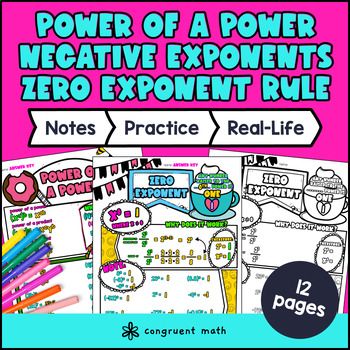Want more ideas and freebies?
Get my free resource library with digital & print activities—plus tips over email.
Join for Free Resources →
$4.25
Ever wondered how to teach the Laws of Exponents: Negative Exponents, Zero Exponents, Power of a Power Rule in an engaging way to your 8th grade students? In this lesson plan, students will learn about these concepts and their real-life applications. Through artistic, interactive guided notes, check for understanding, a maze worksheet, and a doodle & color by number activity, students will gain a comprehensive understanding of the Laws of Exponents.
The lesson culminates with a real-life example that explores how compounding interest works in a retirement account.

$4.25
After this lesson, students will be able to:
Before this lesson, students should be familiar with:
As a hook, ask students why understanding exponential expressions is important. This lesson plan will cover the Laws of Exponents: Negative Exponents, Zero Exponents, and Power of a Power Rule. Students will learn to identify these rules in exponential expressions, simplify expressions using the laws of exponents, and apply their knowledge to real-life situations such as compounding interest in a retirement account.
Walk through each rule using the guided notes and remember to go through a few key examples with your students. Refer to the FAQs below for a walk-through on this, as well as ideas on how to respond to common student questions. There’s a check for understanding integrated into the guided notes. So have students try the practice problems in a group or pairs.
Then, call on students to talk through their answers, potentially on the whiteboard or projector. Based on student responses, reteach concepts that students need extra help with.
Have students practice the Laws of Exponents using the Maze activity. Walk around to answer student questions.
Fast finishers can dive into the Doodle & Color by Number activity for extra practice. You can assign it as homework for the remainder of the class.
Bring the class back together, and introduce the concept of compounding interest in a retirement account and how that’s related to exponents. All the information is laid out in the guided notes as well.
Refer to the FAQ for more ideas on how to teach it!
If you’re looking for digital practice for Laws of Exponents, try my Pixel Art activities in Google Sheets. Every answer is automatically checked, and correct answers unlock parts of a mystery picture. It’s incredibly fun, and a powerful tool for differentiation.
Here’s one activities to explore:
"A fun, no-prep way to practice the Laws of Exponents is Doodle & Color by Number — they’re a fresh take on color by number or color by code. It includes multiple levels of practice, perfect for a review day or sub plan.
Here’s one activities to explore:
The Laws of Exponents are a set of rules that describe how to simplify exponential expressions. There are several different laws, including the Negative Exponent Rule, the Zero Exponent Rule, and the Power of a Power Rule.
Understanding the Laws of Exponents is important because they provide a foundation for working with exponential expressions. Exponential expressions are used in many different fields, including science, finance, and engineering.
A negative exponent is an exponent that is less than zero. The Negative Exponent Rule states that a number raised to a negative exponent is equal to 1 divided by that number raised to the absolute value of the exponent.
A zero exponent is an exponent that is equal to zero. The Zero Exponent Rule states that any number raised to the zero power is equal to 1.
The Power of a Power Rule states that when a base is raised to a power, and that result is raised to another power, the two powers can be multiplied. In other words, (a^m)^n = a^(m*n).
Compounding interest is when interest is calculated on both the initial principal amount and the accumulated interest of a deposit or loan. It is a common concept in finance and investments, and it can be modeled using exponential expressions.
Get my free resource library with digital & print activities—plus tips over email.
Join for Free Resources →